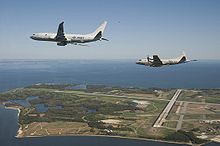
A maritime patrol aircraft (MPA), also known as a patrol aircraft, maritime reconnaissance aircraft, or by the older American term patrol bomber, is a fixed-wing aircraft designed to operate for long durations over water in maritime patrol roles — in particular anti-submarine warfare (ASW), anti-ship warfare (AShW), and search and rescue (SAR).
The first aircraft that would now be identified as maritime patrol aircraft were flown by the Royal Naval Air Service and the French Aéronautique Maritime during World War I, primarily on anti-submarine patrols. France, Italy and Austria-Hungary used large numbers of smaller patrol aircraft for the Mediterranean, Adriatic and other coastal areas while the Germans and British fought over the North Sea. At first, blimps and zeppelins were the only aircraft capable of staying aloft for the longer 10 hour patrols whilst carrying a useful payload while shorter-range patrols were mounted with landplanes such as the Sopwith 1½ Strutter. A number of specialized patrol balloons were built, particularly by the British, including the SS class airship of which 158 were built including subtypes. Later in the war, aircraft were also developed specifically for the role including small flying boats such as the FBA Type C as well as large floatplanes such as the Short 184 or flying boats such as the Felixstowe F.3. Developments of the Felixstowe served with the Royal Air Force until the mid 20s, and with the US Navy as the Curtiss F5L and Naval Aircraft Factory PN whose developments saw service until 1938. During the war, Dornier did considerable pioneering work in all aluminium aircraft structures while working for Zeppelin and built four large patrol flying boats, the last of which, the Zeppelin-Lindau Rs.IV influenced development elsewhere resulting in the replacement of wooden hulls with metal ones, such as on the Short Singapore. The success of long range patrol aircraft led to the development of fighters specifically designed to intercept them, such as the Hansa-Brandenburg W.29.